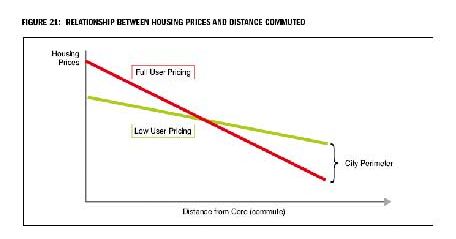Also discussed here: Cities should embrace user fees to fund repairs to aging infrastructure: Report (Manisha Krishnan, Calgary Herald, May 20, 2014)
Today we review a report that analyses why user fees for municipalities are not applied to roads but are happily applied to other forms of public infrastructure such as public transit, waste and water drainage. The costs of road infrastructure tends to come from transfers from the federal or provincial levels (which as a revenue stream has been rising) or from property taxes with very little outside of gas taxes from the users.
The result is that local politicians are shielded from accountability for the condition of roads and, as it affects property taxes which are higher in the urban core, people tend to accept commuting longer distances to buy cheaper properties in the suburbs - which only celebrates urban sprawl and congested highways leading into the cities. It also disadvantages those affected by the added congestion whether it is added congestion from the suburbs or the environmental and health costs borne by those living downtown. Other countries regularly charge road users for roads and bridge infrastructure.
As this report concludes: “To the detriment of their infrastructure, cities across Canada have made insufficient use of user pricing. It is time for a change.”

Key Quotes:
“Municipalities, facing increasingly high bills to repair and replace roads, bridges, and water systems, are too reliant on provincial and federal government subsidies, according to the report… now make up 40 per cent of municipal budgets, a 15 per cent jump over the last 50 years…..Such subsidies lower the political costs for local governments allowing municipalities to maintain artificially low taxes for their constituents by spending federal or provincial tax revenue.”
“Increased reliance on property taxes and other tax bases unrelated to infrastructure costs potentially hollow out the inner city as people and businesses move to other nearby towns with lower taxes, while still using subsidized roads and transit to commute into the city.”
“Greater reliance on infrastructure pricing would also provide two other major benefits. It would impose a higher standard on local spending decisions and it would contribute to accountable decision-making, by creating a direct link between the localized costs that users face for infrastructure and the quality of services that they receive.”
“Though user fees are prevalent for public transit, water and waste, Canadian municipalities …have largely refused to embrace road and congestion tolling, or adopt a larger base for user-pay models to fund new projects, maintenance or additional capacity for existing infrastructure. Aside from international crossings, Canada had only eight tolled bridges in 2012, and less than 0.25 per cent of Canada’s paved public roads were tolled”
“Roads, streets, walks and lighting are highly subsidized, with taxpayers covering roughly 85 per cent of revenues, followed by storm sewers and drainage…About 40 per cent of transit operational revenues are taxpayer funded….About one third of water-supply and waste-treatment operation revenues come from taxpayers in Edmonton,”
” When governments do not price infrastructure to charge households for the marginal costs associated with their commuting, households will be willing to live further away from the core.… this causes housing prices to rise further from the city core, while housing prices fall near the city centre. This leads to urban sprawl as rural areas at the city’s edge are converted into urban residence. Inefficiency is introduced whereby a greater share of the population is more willing to live near the city limits furthest away from a city core, thereby leading to more commuting than would occur if full user-fee pricing were in place."
“The social costs associated with commuting also include environmental costs, accident externalities and transit-service crowding costs.”







No comments:
Post a Comment